There are 40 species of snakes in Arkansas, 6 of which are venomous.
Whether you live in the state and are interested to know what species roam the area or you are thinking of getting a pet snake, there are some things you might want to know about snakes in Arkansas.
In terms of legality, you will need a Venomous Reptile Possession Permit in order to own all native or exotic venomous reptiles. For transporting, you will be required to have an import permit.
Native species of the state may require a Scientific Collection Permit and Conservation Education Permit for transport.
A permit is only not necessary in the case that the species was legally imported to the states.
In most cases, you don’t need any permit to possess the snake, as long as it’s not a venomous species.
Now that you understand more about the legality of snakes in Arkansas, here is our list of common and venomous snakes of the state:
Table of Contents
Snakes in Arkansas
Here are some common snakes that roam the state:
1. Prairie Kingsnake
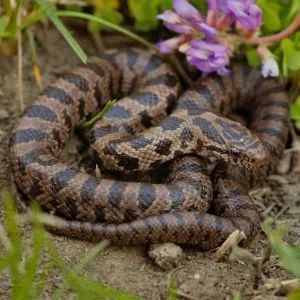
- Experience Level: Beginner
- Family: Colubridae
- Scientific Name: Lampropeltis calligaster
- Other Names: Yellow-bellied Kingsnake
- Adult Size: 30 to 40 inches
- Lifespan: 23 years
This species is typically tan or brownish grey, sometimes with a tint of green-grey and numerous dark brown, copper-colored, or green-brown blotches down their back.
They also have a tan or pale yellow underside and a V- or U-shaped marking on their head.
They can be found in the Southeastern United States, ranging from Maryland to Florida and Nebraska to Texas.
They enjoy habitats with open grasslands that have dry, loose soil near permanent water sources. An example of this type of habitat can include forest edges.
Prairie Kingsnakes typically feed on rodents, but will also consume amphibians, lizards, birds, their eggs, and even other snakes.
When they are feeling defensive, they will shake their tails in a similar manner to a rattlesnake. They may also release musk and flatten their heads in a defensive stance, but don’t be fooled because they will typically not try to bite anyways.
2. Speckled Kingsnake
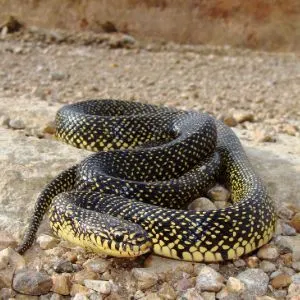
- Experience Level: Beginner
- Family: Colubridae
- Scientific Name: Lampropeltis holbrooki
- Other Names: Speckled King Snake
- Adult Size: up to 48 inches
- Lifespan: around 15+ years
As their name suggests, these snakes are typically yellow or lime green with a black layer then their original yellow or lime coloration speckled on top of that dark, contrasting black. This speckled look is what gives them their name.
Speckled Kingsnakes can be found in the central and southern states from Iowa all the way to the Gulf of Mexico. They make homes out of moist habitats like rivers and swamps but can also be found roaming dry woodlands or grass fields sometimes.
They feed on other snakes and rodents primarily, but will also consume the occasional fish. They will even eat a Cottonmouth if given the chance!
3. Northern Scarlet Snake

- Experience Level: Expert
- Family: Colubridae
- Scientific Name: Cemophora coccinea
- Other Names: Northern Scarletsnake
- Adult Size: 2 feet
- Lifespan: 7 years in captivity; Unknown wild lifespan
These are not recommended to be kept as pets due to their picky appetite and specific needs. They will simply not eat if they are not pleased with their life in captivity.
These guys look very similar to most Kingsnakes with wider red, copper, brownish, or orange stripes alternating black and pale yellow or white. They typically have solid pale yellow or tan undersides.
Northern Scarlets can be found in coastal southern states New Jersey, Oklahoma, and Florida. Although, the subspecies of Scarlets that occur in Florida are called the Florida Scarlet Snake, or Cemophora coccinea coccinea.
They typically live in forested areas with sandy soils where they can burrow, hide under rocks, leaf litter, logs, along with other things.
They will mainly feed on other reptile eggs, but will also consume the occasional frog, lizard, and snake.
4. Eastern Racer
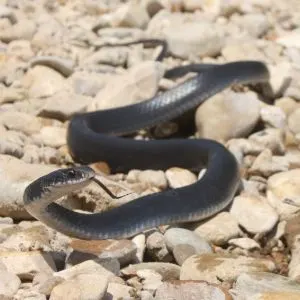
- Experience Level: Intermediate
- Family: Colubridae
- Scientific Name: Coluber constrictor
- Other Names: North American Racer
- Adult Size: Anywhere from 20 to 65 inches
- Lifespan: 10 years
These slender snakes are versatile and are not dangerous or venomous. They are called racers because they are very fast-moving and not docile, which is why they aren’t recommended to keep as pets.
They are mostly docile creatures. However, if they feel threatened, they are ready to defend themselves. In most cases, it can be quite hard for these snakes to become accustomed to handling.
These snakes are silvery-grey and can sometimes be an almost metallic-looking electric blue. Eastern Racers will have a pale yellow or white underside and a black tongue.
A bite from them is shocking but harmless to humans or larger pets like dogs or cats.
They inhabit young or regrowing forest edges and shrubland. These Racers feed on small mammals, insects, smaller snakes, and lizards by swallowing them alive.
5. Milksnake
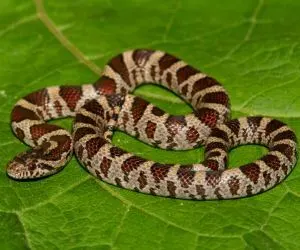
- Experience Level: Beginner
- Family: Colubridae
- Scientific Name: Lampropeltis triangulum
- Other Names: Milk Snake
- Adult Size: About 4 feet
- Lifespan: 22 years
Milk Snakes are a species of Kingsnake that are non-venomous, friendly, docile, and beautiful to look at.
Milksnakes are tan or brown with black-brown bands and blotches that loop around the length of their body. Their skin can sometimes be a pale yellow with almost a red striped pattern, similar to the Western Milk Snake and the venomous Coral snake or a Rattlesnake, depending on the Milk Snake.
They have cat-like pupils that can look intimidating but lack the rattle at the end of their tails.
They can be found in meadows, pastures, under any artificial cover, by the edges of watercourses, by mountain cliffs, and woodlands. These carnivorous snakes feed on lizards, reptile eggs, birds and their eggs, mice, and sometimes insects.
6. Eastern Coachwhip

- Experience Level: Expert
- Family: Colubridae
- Scientific Name: Masticophis flagellum
- Other Names: Whipsnake
- Adult Size: 5 to 8 feet
- Lifespan: 16 to 20 years in captivity; Wild lifespan: 13 years
Coachwhips are thought to be some of the quickest snakes in America.
Coachwhips are fairly slender with distinctive black or dark brown head and ombre colorations with lighter browns and tans down their backs toward their tail.
They have large eyes, which give them great vision as they swiftly sweep the terrain for prey.
You can find them in any dry terrain such as prairies, farmlands, deserts, shrublands, juniper grasslands, creek valleys, and chaparral. You might also find them roaming around agricultural areas with vegetation.
They eat a diet of mainly rodents, frogs, lizards, birds, and their eggs, spiders, and even small venomous snakes. They are also known to eat rattlesnakes if they happen to cross paths with one.
7. Rough Green Snake
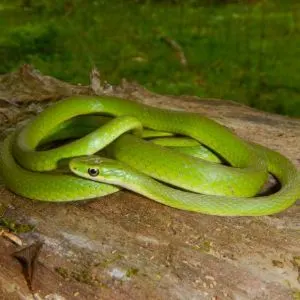
- Experience Level: Beginner
- Family: Colubridae
- Scientific Name: Opheodrys aestivus
- Other Names: Green Snake, Grass Snake
- Adult Size: 2 to 3 feet
- Lifespan: 8 years in captivity; wild lifespan unknown
Rough Green Snakes remain healthy in population and can make great diurnal pets for someone who is more of an observer. They don’t really like being handled and prefer sitting in their enclosure.
They are docile beings and will rarely ever try to bite, if at all.
These green snakes look very similar to their cousins, the Smooth Green Snake, with totally lime green bodies and cream-colored undersides. However, if you want to know the differences between these two, it lies in their scales.
Smooth Green Snakes do, indeed, look smoother due to their flat, shiny scales whereas Rough Green Snakes have more raised scales with keels on the scales covering their dorsal and sides. They will also have larger eyes than their “smooth” counterparts.
These green snakes love to live among the vines, shrubbery, and leaves of trees. They like thick vegetation, lush streamside forests, moist woods, and the gardens in our very backyards.
They usually live off insects like crickets and grasshoppers, but will also consume spiders, small frogs, and snails. They hunt using their large eyes and excellent vision.
8. Great Plains Rat Snake
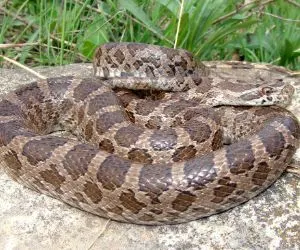
- Experience Level: Beginner
- Family: Colubridae
- Scientific Name: Pantherophis emoryi
- Other Names: Great Plains Ratsnake
- Adult Size: 3 to 5 feet
- Lifespan: 15 to 20 years
The Great Plains Ratsnake is typically a tan or lighter gray in color with brown, dark gray, or greenish-gray blotches down its back and a light tan stripe on each side of its head that meet between its eyes.
They don’t have very large teeth and are non-venomous, but do tend to be bitey. Most of the time they are not aggressive, though.
They live in a wide variety of areas such as brushes, hill prairies, fields, canyons, barnyards, woodlands, riparian areas, and will even make homes out of abandoned houses. They like any place that they can hide under logs, rocks, boards, and even existing abandoned animal burrows.
As their name suggests, rodents will be a huge part of their diet but they also eat lizards, frogs, and birds. They will sit and wait until they see prey before they strike, constrict, and swallow their prey.
They are called Rat Snakes, meaning they can be useful in helping you get rid of the overpopulation of rodents in your home, if needed.
This is why they are beneficial and sometimes kept by farmers.
9. Western Rat Snake
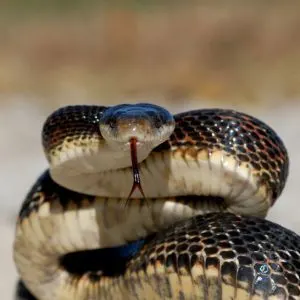
- Experience Level: Intermediate
- Family: Colubridae
- Scientific Name: Pantherophis obsoletus
- Other Names: Black Rat Snake, Pilot Black Snake, Black Snake
- Adult Size: 3 to 6 feet
- Lifespan: 6 to 8 years
Black Rat Snakes are large snakes, growing up to 6 feet long. They are also the most popular type of Rat Snake to keep in America due to their docile nature, hefty size, and ability to help with rodent control.
As their name suggests, they are primarily black in color and may have faint white bands in between their scales. They usually have a white underside starting from their chins downward.
Hobbyists love these interesting creatures for their ability to help with pest control. They are called Rat Snakes, meaning they can be useful in helping you get rid of the overpopulation of rodents in your home, if needed.
This is why they are beneficial and sometimes kept by farmers.
They can be found in mountainous regions, rocky hillsides, or flat farmlands. They survive at various elevations and are actually proficient climbers, making homes in tree cavities that used to be the homes of other animals.
They consume rodents, amphibians, lizards, and also bird eggs.
10. Ground Snake
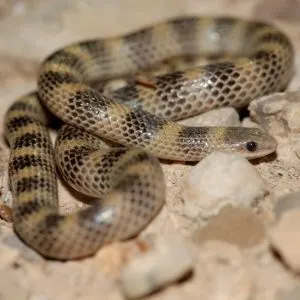
- Experience Level: Beginner
- Family: Colubridae
- Scientific Name: Sonora semiannulata
- Other Names: Variable Ground Snake, Western Ground Snake, Common Ground Snake
- Adult Size: 8 to 19 inches
- Lifespan: estimated 15 years
Ground Snakes will vary in color depending on the individual. Some may be brown, red, or orange. They will usually have a black banding with orange or brown blotches that look like stripes.
Their undersides are solid white or gray. They have smooth scales, round pupils, and a smaller head.
They like to inhabit arid environments that have loose, sandy soil or rocky areas like low desert shrubbery, rims of canyons, outcroppings, and slopes.
This species can mostly be found near the Snake River in Owyhee County.
It is hard to run into these snakes since they are always hiding in debris, but they will usually come out when the sun is about to set. They have been spotted on desert roads before.
Ground Snakes eat invertebrates like spiders, centipedes, crickets, scorpions, and larvae.
11. Flathead Snake
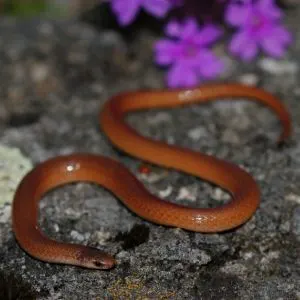
- Experience Level: Intermediate
- Family: Colubridae
- Scientific Name: Tantilla gracilis
- Other Names: Flat-headed Snake
- Adult Size: 7 to 8 inches
- Lifespan: Unknown
This tiny snake is tan or brown sometimes with a lighter underside and, as its name suggests, a flat head.
You can find these little guys in the Lower Rio Grande Valley at the border of Texas and Mexico as well as in Kansas and Missouri. They thrive in moist soil where they can burrow or hide under rocks.
They like rocky wooded hillsides with sandy soils and limestone. They typically burrow underground during the winter or overly hot weather.
Flathead Snakes feed on various insects including scorpions, spiders, centipedes, and more.
12. Midwest Worm Snake
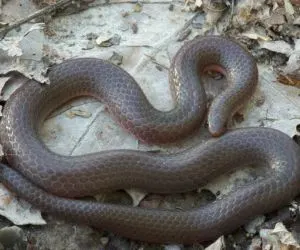
- Experience Level: Intermediate
- Family: Colubridae
- Scientific Name: Carphophis amoenus helenae
- Other Names: Midwest Wormsnake
- Adult Size: 7.5 to 12 inches
- Lifespan: up to 4 years in the wild
Midwest Worm Snakes are not typically recommended as pets due to their picky nature, they usually seem to die very quickly and don’t do well in captivity.
These dark grey worm-like snakes have light peach or pinkish undersides and typically look like an earthworm.
They are endemic to the Midwest and Southern states, usually found in the southern part of Ohio. They like moist, hilly, woodlands, their borders, or farmland, where they like to burrow in loose soil.
They will eat soft-bodied, burrowing prey like earthworms.
13. Western Worm Snake
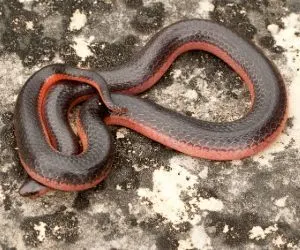
- Experience Level: Intermediate
- Family: Colubridae
- Scientific Name: Carphophis vermis
- Other Names: Worm Snake
- Adult Size: 7.5 to 11 inches
- Lifespan: 4 years in the wild
Since these tiny worm-like snakes can be found in the wild, they can be tempting to take home and try to keep as a pet. However, most of the time, they will die within a week or two in captivity due to their refusing to eat when they are in a changed habitat.
They will also just be hiding in the substrate the whole time since they do not like to be exposed. This will also make it hard for keepers to monitor their health.
You can find them under rocks or underground in exposed prairies, open woodlands, rocky hillsides, and any wooded areas.
They are two-toned with dark black or purple bodies and pink or red bellies.
14. Ringneck Snake
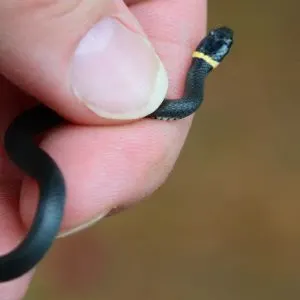
- Experience Level: Intermediate
- Family: Colubridae
- Scientific Name: Diadophis punctatus
- Other Names: Ring-necked Snake
- Adult Size: 10 to 15 inches
- Lifespan: 20 years in the wild; 6 years in captivity
Ringneck Snakes have slender bodies and smooth scales, ranging from black, bluish-black, greenish-gray, to olive in color. Their undersides will usually be yellow, orange, or red with a ring around their neck of the same color.
You can find these snakes in a wide variety of habitats as long as there is a lot of places for them to hide and take cover. They like making dens under woody debris.
They typically feed on terrestrial worms, mollusks, and amphibians.
15. Mississippi Green Water Snake
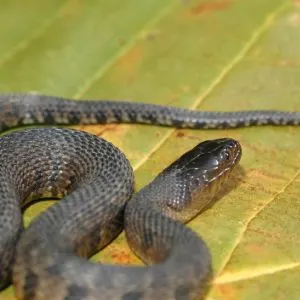
- Experience Level: Intermediate
- Family: Colubridae
- Scientific Name: Nerodia cyclopion
- Other Names: Green Water Snake
- Adult Size: 30 to 45 inches
- Lifespan: 9 years in captivity; Unknown in the wild
Mississippi Green Water Snakes are semi-aquatic, dark green-brown with distinctive scales and dorsal markings on some individuals. Their undersides are dark grey with cream or pale yellow half-moons.
You can find them roaming along the Mississippi River valley and coastlines. They might also be found along the Gulf of Mexico, Illinois, Texas, and Florida.
They will typically choose to live in calmer waters like lakes, swamps, marshes, and ponds. The only brackish waters they might be found in are in the waters along the gulf coast.
They will typically feed on fish just like all water snakes but they will also eat amphibians and crayfish.
16. Plainbelly Water Snake
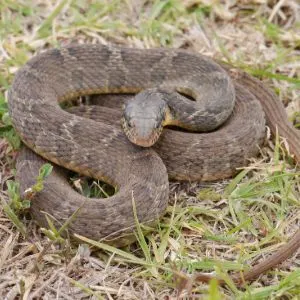
- Experience Level: Intermediate
- Family: Colubridae
- Scientific Name: Nerodia erythrogaster
- Other Names: Plain-bellied Watersnake
- Adult Size: 30 to 40 inches
- Lifespan: 8 to 15 years
This black or dark grey snake has a cream-colored, or pale yellow underside. They are stocky with keeled scales and a divided anal plate.
They are endemic to the Coastal Plain areas of the Southeastern states of America.
Since they are semi-aquatic, they can be found in both terrestrial as well as freshwater habitats. They like warm, temperate climates or tropical climates.
They make homes out of forests, scrublands, and forests or in aquatic habitats such as ponds, lakes, swamps, marshes, riverine sloughs, and bogs.
They feed on fish, carrion, amphibians, and aquatic crustaceans.
17. Broad-banded Water Snake

- Experience Level: Beginner
- Family: Colubridae
- Scientific Name: Nerodia fasciata
- Other Names: Southern Water Snake
- Adult Size: 22 to 36 inches
- Lifespan: 9 years
These rough, dark grey or black snakes have almost brown-red copper-like “burn marks” or blotches along their backs and sides. It almost looks like spilled coffee on a black canvas and their underside is pale yellow or tan.
These watersnakes can be found along the southeastern Coastal Plain of the United States in regions stretching from Alabama to North Carolina. They can also be found in Indiana, Louisiana, and Florida.
They choose to make homes out of freshwater marshes, ponds, streams, lakes, rivers, and swamps.
They feed on aquatic prey such as fish and amphibians.
18. Diamondback Water Snake
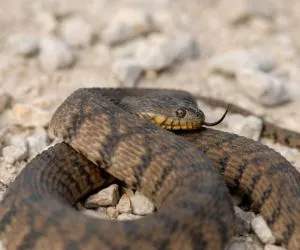
- Experience Level: Intermediate
- Family: Colubridae
- Scientific Name: Nerodia rhombifer
- Other Names: Diamondback Watersnake
- Adult Size: 3 to 5 feet
- Lifespan: 9 years
Diamondback Watersnakes are mostly brown or olive green with a black almost net-like, diamond-shaped pattern, which is where they get their names.
You can find them in the central United States or in the northernmost parts of Mexico. They can also range within a lot of southern states such as Oklahoma, Kansas, Arkansas, Missouri, Illinois, Tennessee, Mississippi, Alabama, Georgia, Iowa, Louisiana, Oklahoma, and Texas.
They inhabit aquatic settings such as lakes, marshes, ponds, rivers, streams, canals, creeks, ditches, and swamps.
They frequent shallow waters looking for amphibians, carrion, and slow-moving fish. They are nocturnal hunters and prefer to feed in warmer weather.
19. Midland Water Snake
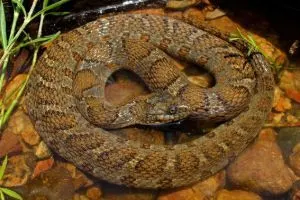
- Experience Level: Intermediate
- Family: Colubridae
- Scientific Name: Nerodia sipedon pleuralis
- Other Names: Midland Watersnake
- Adult Size: 22 to 40 inches
- Lifespan: 10 years
This subspecies of the Northern Water Snake is light brown with darker brown blotches down its back.
They are endemic to both the central and southern states of the United States.
They inhabit freshwater environments such as marshes, streams, ponds, lakes, and rivers where they feed primarily on freshwater fish and amphibians.
20. Graham’s Crayfish Snake
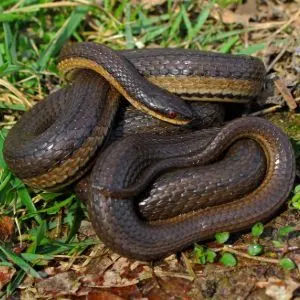
- Experience Level: Intermediate
- Family: Colubridae
- Scientific Name: Regina grahamii
- Adult Size: 14 to 24 inches
- Lifespan: Unknown
Graham’s Crayfish Snakes are a subspecies of Watersnake that shouldn’t be taken out of the wild into captivity.
They are hefty snakes with smooth, dull, brown-olive scales, two light cream or pale yellow stripes down their body, and large eyes with short heads.
They are native to the central United States and are frequently encountered in Iowa.
They like to make homes out of sloughs, floodplains, ditches, marshes, ponds, woodlands, and prairie streams.
They are burrowing snakes that like to make homes near the water’s edge where they feed on amphibians, tadpoles, fish, crayfish, especially newly molted crayfish.
21. Gulf Crayfish Snake

- Experience Level: Intermediate
- Family: Colubridae
- Scientific Name: Regina rigida sinicola
- Other Names: Gulf Glossy Crayfish Snake
- Adult Size: 18 to 24 inches
- Lifespan: Unknown
Gulf Crayfish Snakes are shiny, brown, or olive green with keeled scales and an almost orange-tan underside with two black stripes along their bottom sides to the tail.
They are native to the southeastern states of the United States, where they inhabit ponds, swamps, bogs, rivers, roadside ditches, and streams.
They feed on crayfish primarily, especially those that have only just molted. But they will also consume amphibians, tadpoles, and fish.
22. Queen Snake
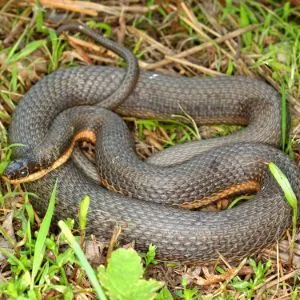
- Experience Level: Beginner
- Family: Colubridae
- Scientific Name: Regina septemvittata
- Other Names: Queen Snake
- Adult Size: up to 24 inches
- Lifespan: over 19 years in captivity; wild lifespan unknown
While these snakes are friendly, docile, and take well to handling, they are listed as an endangered species and protected under the Endangered Species Act by the U.S. Fish and Wildlife Service.
The Queensnake is similar in appearance to the Garter Snake, which causes much confusion when identifying them. They are slender with dark olive or brown bodies with cream or pale yellow stripes along each side of their bodies.
They can be spotted in mountainous regions and sometimes along river drainages. They like to make homes near streams where they hide under rocks and find opportunities to bask in the sun when they can.
They mainly feed on soft, just-molted crayfish without hard exoskeletons.
23. Midland Brown Snake
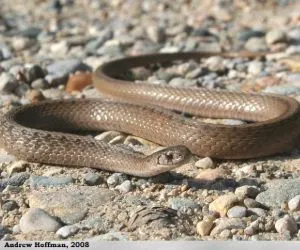
- Experience Level: Beginner
- Family: Colubridae
- Scientific Name: Storeria dekayi
- Other Names: Brown Snake, DeKay’s Brown Snake
- Adult Size: approximately 13 inches
- Lifespan: 7 years in captivity; unknown in the wild
Midland Brown Snakes are not shy and humans commonly encounter them. They can make great pets for beginners due to their size and gentle nature. They are also quite easy to feed.
These non-venomous snakes are usually brown in color, as their name suggests, but can also come in a yellowish, red, or grayish-brown tone.
They will typically have two rows of either darker or lighter spots which might also be linked, making it look like a collar or middorsal streak down the side of their head. Underneath each of their eyes may also be a small, dark spot.
These markings may also not appear on some individuals.
Their undersides will either be white or tan.
They like to reside in various woodlands, more commonly in wet areas like swamp edges or wetland borders. They like to roam the litters of abandoned fields, lowland hardwoods, prairies, and oak savannas.
They are also often spotted in residential areas or urbanized territories.
In their habitats, they will consume small invertebrates like earthworms, slugs, and snails with their specialized jaws and teeth. They may also eat beetles and salamanders if they come across one.
24. Redbelly Snake
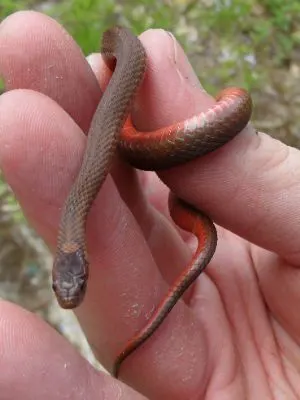
- Experience Level: Intermediate
- Family: Colubridae
- Scientific Name: Storeria occipitomaculata
- Other Names: Red-bellied Snake, Red-belly Snake, Copperbelly Snake, Northern Red-bellied Snake
- Adult Size: 8 to 16 inches
- Lifespan: 4 years in captivity; Wild lifespan unknown but predicted to be longer than in captivity
While Red-bellied Snakes are rarely encountered in the state, they still exist in the wilderness. They are just very secretive.
These small snakes can be found in swarms basking in the sun on the warm days of September to October. You can also find them in woodlands, fields, under logs, in forests, bike trails, back roads, and sphagnum bogs.
In these areas, they feed on earthworms, beetle larvae, and slugs.
People can sometimes find them out in their pesticide-free garden or just out in the wild and might want to keep them as a pet. However, they really struggle to eat when in captivity and will sometimes just outright refuse when they are removed from the wild.
They do not do well in captivity and prefer to be free to roam the lands as they please. Although they aren’t hard to obtain in the wild, they might not be the best pet to keep if you are planning to have them for long since they do not do well away from their natural habitat.
Due to this, you might not run into them as often in the wild since they like to stick to their spaces. They are not as tolerant of populated areas.
It’s not hard to identify these snakes since they really do live up to their name with their flashy red or orange undersides. Their bodies might be a dark steel grey, black with a blue tint, or copper brown. Some may also have two dark stripes along their sides or a thick, light-colored band down the middle of their backs.
While they will usually first curl their tails or flee in defense before they try to bite, their little nibble probably won’t affect you anyway.
While they are small and beautiful, this does not mean they will make a good pet since they do not usually survive long in captivity.
25. Western Ribbon Snake
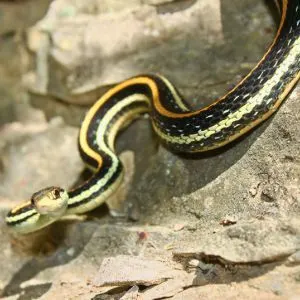
- Experience Level: Beginner
- Family: Colubridae
- Scientific Name: Thamnophis sauritus
- Other Names: Ribbon Snake
- Adult Size: 16 to 35 inches
- Lifespan: 10+ years in captivity; wild lifespan unknown
Ribbonsnakes are the most common species of Garter Snakes there are. These shy, non-poisonous snakes make popular pets due to their many morph options and the fact that they are not dangerous to keep.
These snakes are the best-tempered out of all the subspecies of Ribbonsnakes and can make good pets for novice snake keepers when bought from a reputable pet store where they are captive-bred, of course.
Ribbonsnakes are usually slender-bodied, tan or dark brown with prominent light-colored stripes throughout their length which is usually a bright or pale yellow.
They are semi-aquatic creatures and can be found mostly near a water source like the shorelines of rivers or lakes. They will sometimes inhabit water edges near forests or wetlands.
They are carnivorous and feed on small fish, insects, and tadpoles.
26. Common Garter Snake
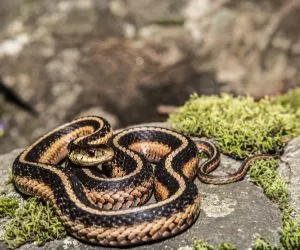
- Experience Level: Beginner
- Family: Colubridae
- Scientific Name: Thamnophis sirtalis
- Other Names: Garter Snake
- Adult Size: 23 to 30 inches; some can grow to 5 feet
- Lifespan: 4 to 5 years in the wild; up to 10 years in captivity
Common Garter Snakes are completely harmless to humans.
These guys are usually relatively small and like to remain active during the day. These guys like to soak often, so they will require a bowl in their tank for them to soak in, especially when it comes time to shed.
Garter snakes are great snakes for beginners since they are docile and will not grow to be too large.
Common Garter Snakes can range from dark olive-green to brown or black with a distinctive yellow stripe running throughout the length of their body.
When threatened, they may let off a musk in order to ward off predators. They can be found in many places like marshes, woodlands, meadows, or hillsides.
These snakes feed on leeches, slugs, worms, small fish, amphibians, and even other snakes. They are also immune to toxic frogs that secrete toxins from their skin in order to drive away prey.
27. Rough Earth Snake
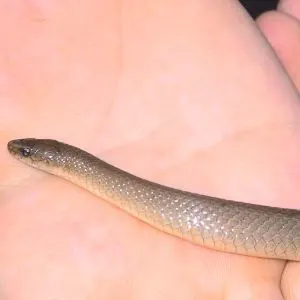
- Experience Level: Intermediate
- Family: Colubridae
- Scientific Name: Haldea striatula
- Other Names: Brown Ground Snake, Ground Snake
- Adult Size: 7 to 10 inches
- Lifespan: 7 years in the wild; significantly less in captivity
These tiny snakes might be super tempting to take into your care if you find one outside, but they really do not take well to captivity and will typically die very quickly. It is best to let them stay in their wild natural habitat.
Rough Earth Snakes are small, worm-like, brown-grey snakes with a tan or cream underside and tiny, beady eyes.
These tiny, worm-like snakes are endemic to many states from Virginia, Florida, the Gulf Coast, Texas, Missouri, and Kansas.
Rough Earth Snakes like to live in forested habitats or any areas that have rocks, leaf litter, compost piles, logs, and any other ground coverage for them to hide under. They can be found in a variety of different areas including urban habitats.
They feed almost exclusively on earthworms, but will also eat other invertebrates such as snails, slugs, larvae, and insect eggs.
28. Western Earth Snake
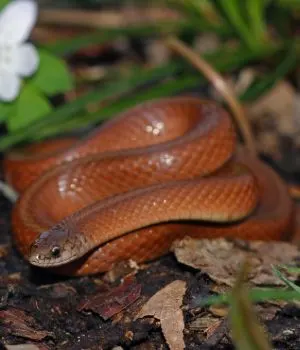
- Experience Level: Intermediate
- Family: Colubridae
- Scientific Name: Virginia valeriae
- Other Names: Western Smooth Earthsnake, Western Ground Snake
- Adult Size: 7 to 19 inches
- Lifespan: Unknown; Shorter in captivity
Western Ground Snakes are on the smaller side and can range from light browns to greys or even a copper-like color. Their undersides are typically cream or off-white and they do not have any distinctive markings.
They are endemic to North America and have many different subspecies that might variate in coloration or patterns depending on their geographical region.
They like to live in habitats that are warm and humid. They prefer woodlands, moist woods, or woody hillsides where they can be found hiding under rocks and leaf litter.
They are nocturnal and like to hunt at night. These snakes feed on soft-bodied insects such as earthworms and slugs.
29. Western Mud Snake
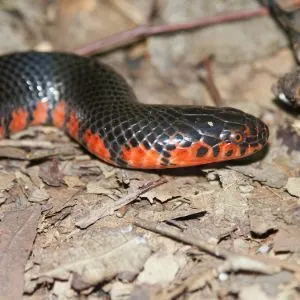
- Experience Level: Intermediate
- Family: Colubridae
- Scientific Name: Farancia abacura
- Other Names: Mud Snake, Mudsnake
- Adult Size: 30 and 54 inches
- Lifespan: 19 years
This shiny snake is black on top with an orange, red, or pink underside that has black banding. They have sharp, pointy tails and dark eyes.
They are native to the Coastal Plain of the southern states from Virginia to Illinois as well as Texas. They inhabit aquatic environments like bays, cypress swamps, slow-moving streams, vegetated lakes, ponds, wetlands, and marshes.
They feed on sirens, eels, amphiumas, salamanders, earthworms, and fish. They enjoy eating slippery prey and can do so with ease because of their muscular jaws and neck.
30. Eastern Hognose Snake
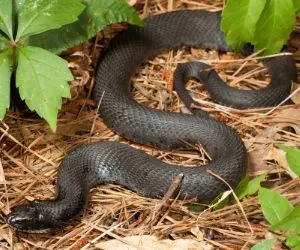
- Experience Level: Beginner
- Family: Colubridae
- Scientific Name: Heterodon platirhinos
- Other Names: Eastern hog-nosed snake
- Adult Size: 20 to 33 inches
- Lifespan: 12 years
The Hognose snake is known to be one of the best pet snakes for enthusiasts since they are not fussy and are comfortable with human interaction. They also stay relatively small.
These worm-like snakes have a large, round head with an upward-facing snout, which is what we all love about them. They are dark gray or olive-green, but some are also yellow, tan, or light brown with dark brown spotted patterns on their head and sometimes their bodies.
They prefer to inhabit sandy woodlands, farmland, coastal areas, and fields where they feed on frogs, salamanders, invertebrates, birds, and small mammals. They can use their hog-like nose to get into their prey’s burrows more easily.
31. Grey Rat Snake
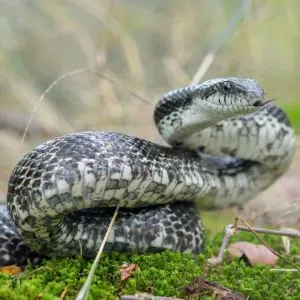
- Experience Level: Beginner
- Family: Colubridae
- Scientific Name: Pantherophis spiloides
- Other Names: Gray Ratsnake, Grey Ratsnake
- Adult Size: 84 to 101 inches
- Lifespan: 10 to 15 years
These snakes range from light to dark grey color with darker markings along their backs. Their undersides are tan or sandy-grey with dark blotches.
These ratsnakes can be found in the central United States from Indiana down to Florida and all the way to Mississippi as well. Some might also be spotted in Ontario, Canada as well.
They inhabit forests and also like warm, grassy areas where they can eat frogs, birds, bird eggs, lizards, and rodents through constriction.
32. Bullsnake
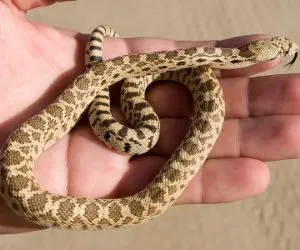
- Experience Level: Intermediate
- Family: Colubridae
- Scientific Name: Pituophis catenifer sayi
- Other Names: Bull Snake
- Adult Size: up to 8 feet
- Lifespan: up to 30 years in captivity; 12 years in the wild
Bullsnakes are a subspecies of the Gophersnake. They can make good pets once accustomed to handling and captivity, which is why you want to look for captive-bred species.
They are large constrictor snakes, though, meaning that they strangle their prey. This species will sometimes do this to more than one animal at a time. You also shouldn’t be too surprised if they try to bite.
Bullsnakes are often mistaken for rattlesnakes due to their similar behaviors. However, they are not as large, have round pupils, narrower heads, don’t have pits over their nostrils, and don’t have rattles on their tails.
These non-venomous snakes are hefty and large with a cream-colored or pale yellow body with brown, black, or copper blotching all throughout. Their heads and necks are almost the same in width as well.
They can be found in open country environments like old fields, native or bluff prairies, pastures, oak savannas, and steep hillsides. They roam sandy-soiled areas where rodents burrow and may also take shelter in agricultural fields, open forests, brush, and any sandy area.
These powerful constrictors live off gophers as well as other small mammals like mice and squirrels. They will also consume amphibians, birds, and their eggs.
33. Northern Pine Snake
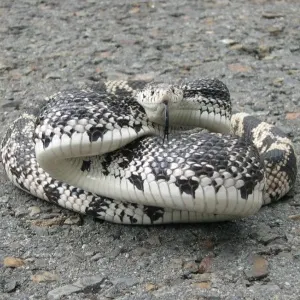
- Experience Level: Beginner
- Family: Colubridae
- Scientific Name: Pituophis melanoleucus
- Other Names: Pine Snake, Northern Pinesnake, Pinesnake
- Adult Size: 48 to 66 inches
- Lifespan: up to 20 years
This snake might have a light grey, white, yellow, or pale coloration with brown blotching or spots all over.
While their range is a bit patchy, you can find them across the southeastern states such as North and South Carolina, Georgia, Virginian mountains, Tennessee, Georgia, and throughout Florida.
They like to inhabit areas with sandy soils and places like pine woods with dry upland forests.
These powerful constrictors can eat a lot of rodents like gophers, rabbits, rats, and mice. They also prey on terrestrial birds and their eggs when given the chance.
34. Lined Snake
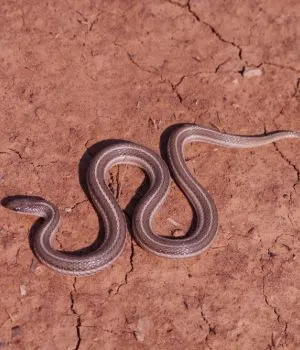
- Experience Level: Intermediate
- Family: Colubridae
- Scientific Name: Tropidoclonion
- Adult Size: 8 to 12 inches
- Lifespan: 3 to 10 years
We do not know much about Lined Snakes except that they are closely related to Garter Snakes, which help give us a little more information about these cute little critters.
These nocturnal snakes can often be found in urbanized areas, often discovered in parks, grassy areas, vacant lots, and under debris. They might also inhabit grasslands, abandoned prairies, woodland passages, oak forests, and suburban or residential areas.
They like to hide or find places to take shelter and will emit a musk if they are discovered or captured. They will rarely try to attack or bite someone.
They will often hide under leaf litter, rocks, or might burrow in the soil.
These tiny snakes basically look like mini Garter Snakes with brown or gray-brown bodies and dark stripes that can range from olive-gray to different ranges of grays.
Their undersides are cream-colored with two rows of gray blotches or spots. You may also find half-moons along their midline.
Venomous Snake Species in Arkansas
Here is a list of the most venomous snakes that roam the state:
35. Western Diamondback Rattlesnake
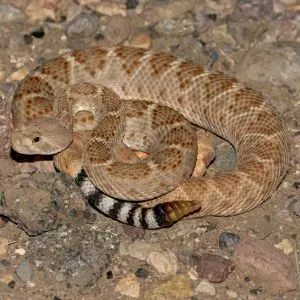
- Experience Level: Expert
- Family: Viperidae
- Scientific Name: Crotalus atrox
- Other Names: Western Rattlesnake
- Adult Size: up to 5 feet
- Lifespan: 15 to 20 years
Western Rattlesnakes are typically dusty gray or brown with some pink-brown, brick red, yellow, chalky white, or pink. They also have dark gray or brown dorsal blotches throughout their body.
They have a triangular head and are heavy-bodied. Since it is, indeed a rattlesnake, we can’t forget to mention that it has a rattle at the end of its tail! This species has black and white stripes right underneath it, too.
These guys aren’t that picky about where they live and can be found in rocky areas seeking shade under rocks or other debris. They can also swim, which makes it possible to find them around water as well.
They feed on small mammals like prairie dogs, gophers, squirrels, rabbits, chipmunks, mice, and rats. They might also eat a bird if it comes within its reach.
36. Timber Rattlesnake
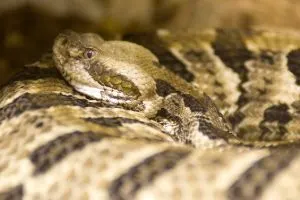
- Experience Level: Expert
- Family: Viperidae
- Scientific Name: Crotalus horridus
- Other Names: Canebrake Rattlesnake, Banded Rattlesnake
- Adult Size: 6 feet
- Lifespan: Anywhere from 10 to 30 years in the wild; 30+ years in captivity
Rattlesnake bites are very serious and should be treated as a medical emergency. However, they are also somewhat timid creatures, meaning they are not often spotted.
These vipers are usually gray or yellow-brown in color with dark brown blotches all or bands throughout their body and a brown, yellow, or copper stripe running down the length of their back.
They can generally be found in bluffs, croplands, rugged deciduous forest terrains, rocky ledges, and dense woodlands with closed canopies. They like to move around during different seasons and females will move to rocky terrains when they are pregnant for higher temperatures.
Timber Rattlesnakes feed mainly on smaller mammals but will also eat the occasional bird if they feel like it.
37. Copperhead
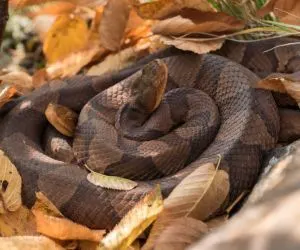
- Experience Level: Expert
- Family: Viperidae
- Scientific Name: Agkistrodon contortrix
- Other Names: Eastern Copperhead, Copperhead Snake
- Adult Size: average 2 to 3 feet; up to 4 feet
- Lifespan: 18 years
Copperheads aren’t aggressive towards humans unless provoked, which is why bites from them are somewhat rare, even in areas that they have been spotted.
These large snakes are tan in color with copper or rusty-looking, chestnut, blotches all throughout their bodies which look like spilled coffee spots. These pit vipers have a distinctively triangular-shaped head.
They can be found in a variety of environments anywhere from semiaquatic to terrestrial. This includes wetlands, hillside forests, rocky areas, and abandoned construction sites in the suburbs where they can find rotting wood or piles of sawdust.
These snakes are carnivorous, eating mostly small rodents like mice. They also consume other smaller snakes, lizards, insects, amphibians, and birds.
They do their hunting by ambushing their prey, injecting them with venom, then swallowing it whole.
38. Cottonmouth
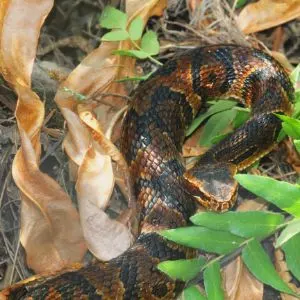
- Experience Level: Expert
- Family: Viperidae
- Scientific Name: Agkistrodon piscivorus
- Other Names: Water Moccasin
- Adult Size: 4 feet
- Lifespan: 10 years
Also known as Water Moccasins, Cottonmouths are generally dark brown or duller black with lighter side banding on some individuals.
These can be found in the Coastal Plain but can also be found throughout Piedmont of Atlanta, Georgia.
They prefer moist habitats like marshes, swamps, roadside ditches, streams, lakes, and retention ponds.
They feed on small mammals, birds, lizards, amphibians, fish, crayfish, insects, turtles, and even other snakes.
39. Western Pygmy Rattlesnake
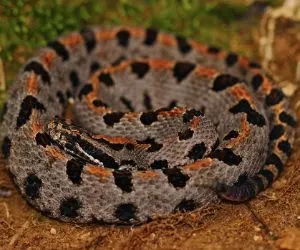
- Experience Level: Expert
- Family: Viperidae
- Scientific Name: Sistrurus miliarius streckeri
- Other Names: Pygmy Rattlesnake, Dusky Pygmy Rattlesnake
- Adult Size: 16 to 25 inches
- Lifespan: 6 to 15 years
These light grey or tan snakes are thick-bodied with a line of black dots alternating with a brown or reddish-orange stripe along with the spots. Their undersides are typically offwhite with dark spots.
They can be found across the western to the eastern United States like Mississippi, Louisiana, Texas, Oklahoma, Missouri, Arkansas, and Tennessee.
They inhabit environments that are near water such as marshes, swamps, and creeks, but can also be found in mixed pine and hardwood forests, pine and oak sandhills, scrub pine woods, swamps, and xeric uplands.
Typically, these carnivores will feed on terrestrial vertebrates, insects, reptiles, amphibians, and mammals.
40. Texas Coral Snake
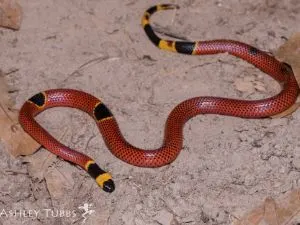
- Experience Level: Expert
- Family: Elapidae
- Scientific Name: Micrurus tener
- Other Names: Texas Coralsnake
- Adult Size: 24 to 48 inches
- Lifespan: 7 years in captivity
These dangerous snakes will sometimes look similar to more friendly, non-venomous snakes, so be aware. As they say in Texas, “Red touch yellow, kill a fellow.”, which is the saying to help distinguish this snake from milksnakes or other red-black striped snakes.
The difference with these snakes is not only will they alternate red and black, but there will be thin, yellow bands as well. Look out for that.
They are native to the southern United States as well as northeast and central Mexico.
They like to inhabit environments like mixed forests, grasslands, savannas, deserts, shrubland, woodlands, and vegetation along streams, creeks, and rivers.
These carnivores eat other snakes, mainly earthsnakes. They will also eat smaller lizards and the occasional rodent.
Conclusion
Arkansas has a variety of many awesome, beautiful, and dangerous snakes.
We hope that this list helped you decide which one you might want to keep as pets or that you learned something about some of the more interesting, venomous snakes that you can’t keep as pets.
Leave us a comment down below if you own one of these snakes or know something interesting about snakes in Arkansas that we don’t!
Snakes in other states
References
https://www.swtimes.com/story/lifestyle/2021/04/03/six-snakes-arkansas-venomous/4807305001/
https://www.landcan.org/pdfs/Arkansas%20Snake%20Guide.pdf

rc
Friday 12th of August 2022
What is a black snake with a white strip down its back